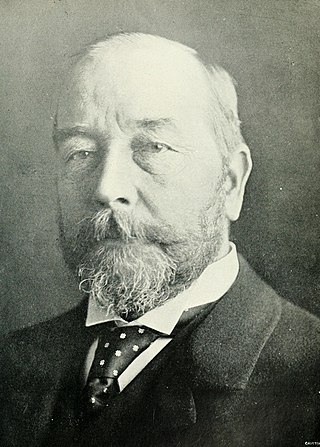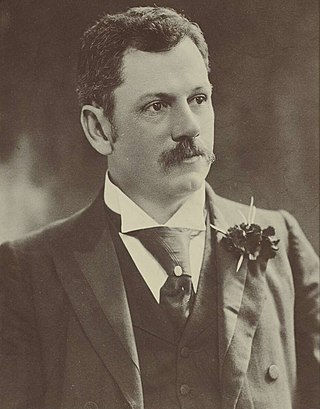Members of the New South Wales Legislative Assembly who served in the 52nd parliament held their seats from 1999 to 2003. They were elected at the 2003 state election, and at by-elections. The Speaker was John Murray.
The Progressive Party was an Australian political party, active in New South Wales state politics. The question of tariff policy which, had created and divided the Free Trade Party and Protectionist Party in New South Wales in the 1890s, became a federal issue at the time of federation. Deprived of their main ideological difference, the two parties were recreated as the Liberal Reform Party aligned with the federal Free Trade Party and the Progressive Party aligned with the federal Protectionist Party.
Warringah was an electoral district of the Legislative Assembly in the Australian state of New South Wales and named after and including the Warringah region of the northeastern suburbs of Sydney. It was created in 1894, when multi-member districts were abolished, and the three member district of St Leonards was divided between Warringah, St Leonards and Willoughby. It was abolished in 1904 as a result of the 1903 New South Wales referendum, which required the number of members of the Legislative Assembly to be reduced from 125 to 90, and was partly replaced by Middle Harbour.
A political family of Australia is a family in which multiple members are involved in Australian politics, particularly electoral politics. Members may be related by blood or marriage; often several generations or multiple siblings may be involved.

Dugald Thomson was an Australian politician. He campaigned for Federation as a member of the New South Wales Legislative Assembly (1894–1901), and was subsequently elected to the new federal House of Representatives (1901–1910). He served as Minister for Home Affairs in the Reid government from 1904 to 1905.

Francis Clarke was an Australian politician.

John Thomson was an Australian politician. He was a Progressive Party member of the New South Wales Legislative Assembly from 1901 to 1904, representing the Manning electorate. He was then a member of the Australian House of Representatives from 1906 to 1919, representing Cowper for the Protectionist Party and its successors the Commonwealth Liberal Party and Nationalist Party.
Members of the New South Wales Legislative Assembly who served in the 35th parliament held their seats from 1947 to 1950. They were elected at the 1947 state election, and at by-elections. The Speaker was Bill Lamb.
Members of the New South Wales Legislative Assembly who served in the 34th parliament held their seats from 1944 to 1947. They were elected at the 1944 state election, and at by-elections. The opposition Democratic Party merged into the nascent Liberal Party in late 1944, becoming the New South Wales branch of the new party. The Speaker was Daniel Clyne.
Members of the New South Wales Legislative Assembly who served in the 25th parliament of New South Wales held their seats from 1920 to 1922. They were elected at the 1920 state election on 20 March 1920. The Speaker was Daniel Levy with the exception of 13–20 December 1921 when he was replaced by Simon Hickey.

The See ministry was the 30th ministry of the New South Wales Government, and was led by the 14th Premier, Sir John See. The title of Premier was widely used to refer to the Leader of Government, but was not a formal position in the government until 1920. Instead the Premier was appointed to another portfolio, usually Colonial Secretary.

The Carruthers ministry was the 32nd ministry of the New South Wales Government, and was led by the 16th Premier, Joseph Carruthers. The title of Premier was widely used to refer to the Leader of Government, but was not a formal position in the government until 1920. Instead the Premier was appointed to another portfolio, usually Colonial Secretary. In this case, Carruthers chose the portfolio of Treasurer.
Ellison Wentworth Quirk was an Australian politician. He was an Alderman and member of the New South Wales Legislative Assembly, representing the electorate of Warringah from 1901 to 1904.
There were 373 candidates contesting 125 seats at the 1901 New South Wales state election which was held on 3 July 1901.

The 1898 New South Wales colonial election was held on 27 July 1898 for all of the 125 seats in the 18th New South Wales Legislative Assembly and it was conducted in single-member constituencies with a first past the post voting system. Section 23 (1) of the Parliamentary Electorates and Elections Act of 1893 conferred a right to vote on 'every male person, being a natural born [British] subject, who shall have resided or had his principal place of abode in New South Wales for a continuous period of one year'. The 18th parliament of New South Wales was dissolved on 8 July 1898 by the Governor, Lord Hampden, on the advice of the Premier, George Reid.
The 1904 New South Wales state election involved 90 electoral districts returning one member each. The election was conducted on the basis of a simple majority or first-past-the-post voting system. There were two significant changes from the 1901 election, the first was that women were given the right to vote, which saw an increase in the number of enrolled voters from 345,500 in 1901, to 689,490 in 1904. The second was that as a result of the 1903 New South Wales referendum, the number of members of the Legislative Assembly was reduced from 125 to 90. The combined effect of the changes meant that the average number of enrolled voters per electorate went from 2,764, to 7,661, an increase of 277%. Leichhardt was the only district that was not substantially changed, while The Macquarie and The Murray districts retained nothing but the name.
The 1901 New South Wales state election was for 125 electoral districts, with each district returning one member. The election was conducted on the basis of a simple majority or first-past-the-post voting system. In this election, in 32 electorates the winning candidate received less than 50% of the votes, while 13 were uncontested. The average number of enrolled voters per electorate was 2,764, ranging from Wentworth (1,706) to Willoughby (4,854).
The Hastings and The Macleay, an electoral district of the Legislative Assembly in the Australian state of New South Wales was created in 1894 and abolished in 1920.
Sydney-Fitzroy, an electoral district of the Legislative Assembly in the Australian state of New South Wales, was created in 1894 and abolished in 1904.
Warringah, an electoral district of the Legislative Assembly in the Australian state of New South Wales was created in 1894 and abolished in 1904.









